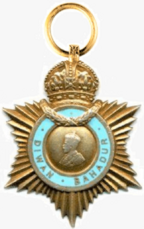Title Badge (India) facts for kids
Quick facts for kids Title Badge |
|
|---|---|
 
Insignia for Diwan Bahadur and Rao Bahadur
|
|
| Type | Title holder's insignia |
| Eligibility | Native Indian civilians and Viceroy's commissioned officers |
| Awarded for | Faithful service or acts of public welfare |
| Status | No longer awarded |
| Statistics | |
| Established | 12 December 1911 |
Ribbon: 1st class Ribbon: 2nd class Ribbon: 3rd class |
|
Title Badges were special awards given to people in India during the time of British rule. These badges were for Indian citizens who had received certain important titles. They were no longer given out after 1947, when India became independent.
Contents
Why Were Title Badges Created?
Before the British arrived, Indian rulers already gave out special titles to important people. The British continued this tradition. They used these traditional Indian titles to reward local Indian civilians. They also gave them to Indian officers in the Indian Army. These awards were for loyal service and for helping the public.
In 1911, King George V held a big event in India called the Delhi Durbar. At this event, he decided to create special badges. These badges allowed people to show off the titles they had received. The awards stopped being given in 1947, when India gained its independence.
Different Kinds of Badges
There were three main types, or classes, of Title Badges. Each class also had different names depending on the person's religion or where they lived.
First Class
- Nawab Bahadur: This title was usually for Muslims.
- Diwan Bahadur: This title was usually for Hindus.
Second Class
- Khan Bahadur: This title was usually for Muslims.
- Rai Bahadur (North India) or Rao Bahadur (South India): These titles were usually for Hindus.
Third Class
- Khan Sahib: This title was usually for Muslims.
- Rai Sahib (North India) or Rao Sahib (South India): These titles were usually for Hindus.
People of other religions received the title that seemed most fitting. For example, Indian Christians with Hindu-sounding names might get a Hindu title. Jewish people might receive a Muslim title.
These Title Badges were very important. They came after all British and Indian medals for bravery. They were more important than medals given for military campaigns. Most people started with a lower class title and then moved up. They would only wear the badge for their highest title. If someone who had a Title Badge later became a knight, they would stop using the old title. Knighthoods were even higher honors, like the Order of the Star of India.
What the Badges Looked Like
The Title Badge looked like a shining star. It had a royal crown on top and a laurel wreath below the crown. In the middle, there was a round part with the title written on it. This round part surrounded a picture of the king's head. It showed either King George V or King George VI. Until 1933, King George V's picture faced right. After that, it faced left. King George VI's picture always faced left.
The back of the badge was plain. It had the name and other details of the person who received it.
All three classes of badges were the same size. They were about 58 millimetres (2.3 in) tall and 45 millimetres (1.8 in) wide. What made them different was their metal color and their ribbon:
- First Class: This badge was made of silver with a gold coating. The title in the middle was colored light blue. The ribbon was light blue with dark blue edges.
- Second Class: This badge was also silver with a gold coating, but it had no colored enamel. The ribbon was red with dark red edges.
- Third Class: This badge was made of silver. The title in the middle was colored dark blue. The ribbon was dark blue with light blue edges.
All three badges were worn around the neck. They hung from a ribbon that was about 39 millimetres (1.5 in) wide. Sometimes, people would unofficially wear the badge on their left chest, next to other medals.
Images for kids
See also
- Raj Ratna
- Dewan



